The aura surrounding songstress Valerie June feels almost otherworldly. There's the goddess hair, the genuine light that comes from her kind eyes and beaming smile, and the music she makes has an unmistakable, singular sound that's hard to place. And at the same time, the good-vibes Humboldt, Tennessee, native, who once dubbed her musical thing as “organic moonshine roots," blends ethereal, gospel-influences and down-home, guttural country-blues with formidable swagger. As the final track on her new album aptly testifies, she's “Got Soul."
And when she says, “I hear voices," she means it. Since she can remember, songs have just come to her, arriving in her mind's eye seemingly out of nowhere. “I'm just washing dishes, and I'll hear a voice and start singing along like if you were listening to the radio and started humming along [laughs]," June says. “And then I'm like, 'Oh my god, I'm writing a song. Okay!' Then I start to write it down, or if I can't write it down, then I just keep singing what I'm hearing on repeat until I get to a place where I can write it down. That's pretty much how it happens for me."
Growing up singing in church, she learned how to express herself through a voice that didn't always fit in. For this songwriter, everything comes from the hip and the heart: the emotion is palpable in her words, and her idiosyncratic vocal yowls. With the voices behind the wheel, eventually she wanted to accompany her gift on stringed instruments.
June is a late-bloomer when it comes to guitar. Citing Mississippi John Hurt as a main influence, she taught herself the basics at 23 and kept building upon that foundation as a way to support the songs she heard in her head. Now armed with her “babies"—an assortment of banjos, her Martin, and her new favorite, a 1960 Guild M-75 Aristocrat—she's developed a rhythmic, primal, fingerpicking style that's resonated with blues fans.
June says that working with Dan Auerbach on her first full-band production, 2013's Pushin' Against a Stone, taught the self-described technical rookie more about working with other musicians than anything else. This time around, everything seemed to coalesce when she started collaborating with Matt Marinelli [see sidebar: “Studio Libero"], who ended up producing her new album, The Order of Time.
“Matt found musicians he felt would understand these particular songs and be able to get in the room and bring some magic," June says. “It was like, whoa—'we can go anywhere with this. But where do I want to go with this?' Then after that, they would interject ideas as well, so it became a collaboration at a certain point."
Themes of space, chaos, and, eventually, the aligning of life's events float in and out of the dozen songs, both literally and aurally. A track dear to June's heart is “Shakedown," which features guest vocals from her late father, Emerson Hockett, who passed last November, and two of her brothers, Jason and Patrick Hockett. It's a vibrant hoedown featuring African rhythms and call-and-response between the family members.
The record's lush, atmospheric instrumentation is especially notable to those familiar with June's stage appearances, and should be applauded for accentuating, and not obscuring, an artist whose foundation was built upon bare-bones banjo and guitar. Many of the tunes are textured with carefully placed pedal steel, tasteful and minimal guitar solos, and more lively choices like horns, organ, and fiddle.
“That might've been the hardest thing to do on the record—trying to figure out how to do just enough embellishment to where it has an impact, but not too much where it starts eating up all the space," Marinelli says.
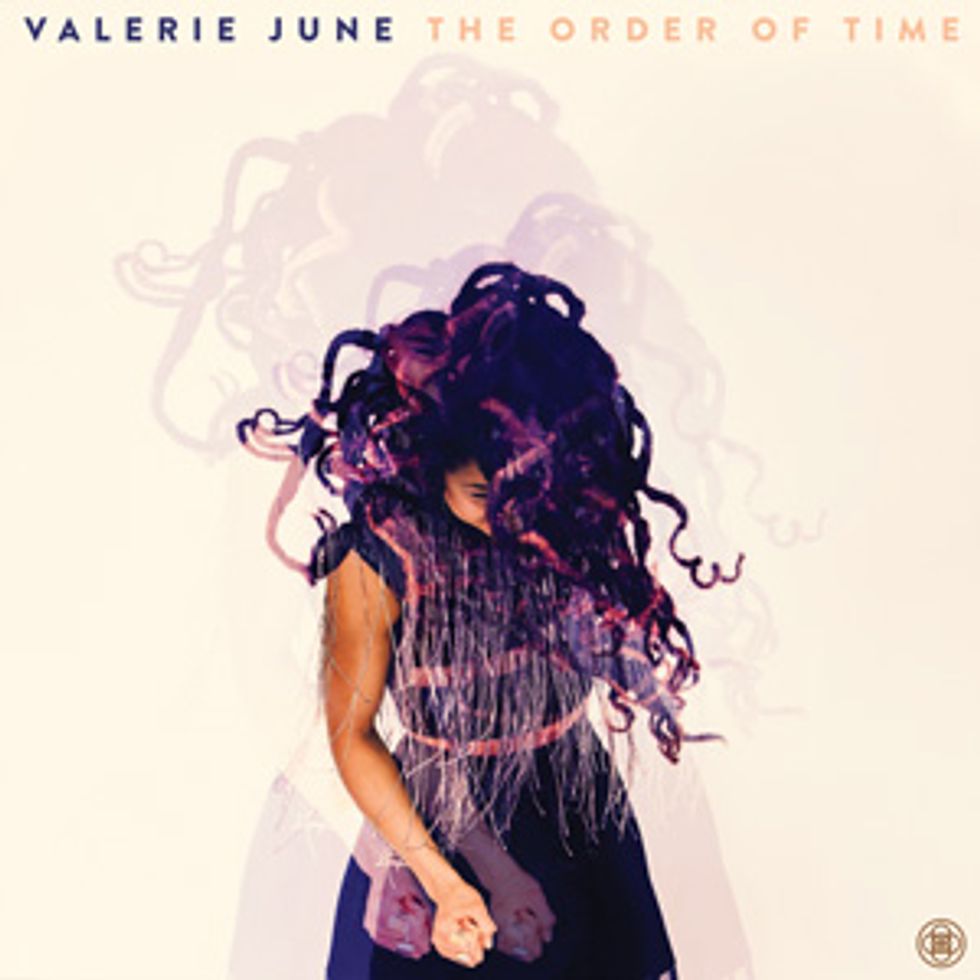
June wrote most of the songs on The Order of Time over the course of 10 to 12 years, but the album started to develop organically when June and producer Matt Marinelli played many of the tunes as a duo in Brooklyn.
On a sunny February day, from her home in Brooklyn before heading out to do errands, the charismatic June discussed her West Tennessee upbringing, how she learned to accompany that inner muse, and how tickled she was when her beloved father compared her to Jack White.
Can you take us back to the moment you first knew that music was what you were supposed to be doing?
When I was a little girl I used to write songs about trees and frogs and rainbows and stuff like that. I knew that's what I wanted to do when I grew up, but I didn't think it was possible for me, because I was just, like, this girl from a small town, so who cares about me, you know? I just didn't know how I was going to get from my small town out into the world to playing, singing, doing that thing. All the steps were pretty unclear, but I knew that I loved singing and writing songs.
What was your first instrument?
The first instrument, besides my voice, was the guitar. I got an acoustic guitar when I was 15. My grandfather gave it to me but I didn't learn how to play it then. I just had it around and let it get dusty, while I was out cheerleading and chasing football players [laughs]. It happens: People have dusty instruments around the house.
When I got into my early 20s, my band broke up. I was just singing and writing songs for the band, I wasn't playing. So, when the band broke up I had to learn to play an instrument because I didn't want to be in the middle of the room trying to sing and that's all I can do. I felt I was out of business so I started teaching myself basic guitar.
The first time I saw you perform, opening for Sharon Jones, you were a one-woman force out there playing your banjo and guitar and singing. How did you go about finding your voice as a musician?
I believe that finding your voice is an ever-present experience. You have to be constantly walking into your voice. Because voices change, and my voice as a little girl is so different than my voice now, and my voice before I went on tour for three years playing night after night is very different than my voice now.
I listen to voices that I love—I love Joni Mitchell's voice and how her voice just changed over the years, you know? I love Stevie Nicks' voice. And you can't tell me that that woman's voice doesn't sound different on the early stuff she did. The “Landslide" voice is the older voice, but the early stuff is a voice that has a brightness and it's so different. I love the way voices change and the way time affects voices. To me, I can feel it in my voice in a day. I wake up in the morning and my voice is deep and low and I sound like a man, and I'm like, “I can sing blues now!" [Laughs.] And then later in the day it's higher, and I can put on Alison Krauss and sing along with her. The voice just changes, and it's every day that you're discovering, “Where is my voice today?"
June rocks a custom 4-string baby ukulele banjo made by Memphis banjo luthiers Tommy George and Christian Stanfield. Her collection of banjos includes two vintage ones that stay at home: a 1930s Gibson model and a 1930s Vega
that Ry Cooder gave to her. Photo by Jordi Vidal
What was it like touring with Sharon Jones?
She was a force. I get inspired thinking about it because, she was just, like, “l'm going to take my life and do what I wanna do with it, and what I wanna do with it is play music. I'm gonna do it every day until the day I leave this planet. And I don't care what anybody's got to say about it, I'm doing it." And so that fearlessness, and being such a fierce woman, and fighting back in so many ways through so many things, is just inspiring. I learned a lot. I'm still learning from her.
During an AmericanaFest 2015 performance, you shared this story about how your dad said he saw a white guy playing the blues and it sounded like you. It turned out to be Jack White. What did you think about that when he first said that to you?
Well, I laughed because I didn't really think my dad got what I was doing. I was living in Memphis, I had my 12 to 15 jobs, and I was playing music and burning my own CDs, and hustlin', trying to get 'em out. I just didn't think my dad really understood what I was trying to do musically because his framework was for R&B and gospel music.
And so, I was like, “What?" My dad kept trying to come up with the guy's name. “It started with a J and his last name started with a W. Maybe it was Johnny Wilkins, I don't know?" I kept guessing and finally I said, “Was it Jack White?" And he's like, “Oh yeah!"
I just laughed so hard because, first of all, my dad, over the course of his life, worked with so many entertainers. He put on one of Prince's first shows. He worked with Bobby Womack on a show. He would come home and tell us stories about people he met. To me, this was another one of my dad's old stories, like, “That old man—he doesn't know what he's talking about." And then I looked it up and Jack White did play in Jackson, Tennessee, that night! It was hilarious.
Jack's brother invited my dad into the soundcheck, and he said they were the sweetest people ever. He said, “I couldn't believe all them white folks standing up in there rocking out." It was hilarious just listening to my dad—who's this old black man who grew up listening to R&B and soul and gospel—listening to him translate to me what he thought was similar to what I do. And I thought, if I'm getting through to my dad, and he doesn't even listen to the kind of music I like, I might be getting through to other people. And that was way before Pushin' Against a Stone came out.
You've named Mississippi John Hurt as an influence. Who were some of your other guitar influences?
The people I loved guitar-wise were folk and blues, simple music, not shredding, just playing a few chords with a couple variations. I started too late to even get my head around shredding. I couldn't even get my chord A to chord B to chord C [laughs], so I had to lead with something that's a little more straightforward and down to earth with the changes. And I felt like the stuff John Hurt and the Carter Family were doing was stuff I could do. And so that's where I started. But I've always called it a roots kinda thing, like that was a root of where the music could go. If I start with this root, if I start with this foundation and simplicity and I get that down in my own way, then I can begin to blossom out into other avenues and see where it can really go.
That was the start and from there it just kept growing. There are so many musicians who I love the way they play. It just keeps changing. I love Nick Drake; I love the way he fingerpicks. I don't know if I'd ever be able to play that way but I just love it. Of course, I love Hendrix. Who doesn't? And I look at that and say, “Oh my god, I'm 35 now. Maybe by the time I'm 105 I'll have it [laughs]!" And I felt the same way about a John Hurt song when I was 23. I was like, “Hmmm, maybe by the time I'm 80 I'll be able to play a John Hurt song." So, I've always kept the goals, and the idea of this coming into fruition as a faraway thing, but work every day toward trying to get there. Because how cool would it be to be 80, sitting around, and able to play a Hendrix tune? That would be kinda great.
Valerie June's Gear
GuitarsNew Martin 000-15M (live)
1960 Guild M-75 Aristocrat (live)
Gold Tone 5-string banjo (studio and live)
Custom George 4-string baby ukulele banjo (live)
1955 Martin 0-15 (studio)
1962 Gibson ES-330 TDC (studio)
1930s Gibson Mastertone 5-string resonator banjo
1930s Gibson EPB-150 Electric Plectrum Banjo
Amps
Fender Deluxe Reverb Reissue (live)
1960s Fender Princeton Reverb (studio)
1970s Fender Super Six (studio)
1950s and '60s Magnatone amps (studio)
1963 Gibson GA-79RVT (studio)
Effects
Fulltone OCD (live)
Strings
D'Addario ECG23 Extra Light (.010–.048)
Martin Acoustic Light (.012–.054)
Can you talk a little about your songwriting process?
I really think it's a lot like a person who writes arrangements for other people, or writes
symphony arrangements where they hear what the music is in their head. They just hear a band in their head all the time. But with me, instead of hearing a band or an orchestra, I hear voices. I hear the voices in my head first and then start to translate what I'm hearing. That's pretty much it. I'll be walking down the street, sometimes waking up, sometimes sleeping, or washing dishes or whatever, and I'll just hear a voice. Sometimes I don't even realize that I'm hearing it.
How was making The Order of Time different
or similar to making Pushin' Against a Stone?
In general, I was saying what was on my mind, versus with Pushin' Against a Stone I was more in a place that was more inquisitive and learning how to even speak to a musician. Having Matt in the room on this record was really great, because I'm still learning how to speak to musicians. I'd be talking to people that started playing when they were, like, 2 or 3, and I started playing when I was 23. I don't know how to read music so I can't really tell you what to do where, but I know when something's not sitting the way I want it to. Of course, ultimately it's my record so if I don't like the way the drummer's playing I can just say something like, “That's a little too hard for this song. I had something a little more ethereal in mind," or whatever.
I can use colors, like, “It needs to be a little more gray and then a little bit cloudy and then maybe some fog…" I use terms like that and Matt uses musical terms and was able to turn that into what I was thinking as a musician. Matt knows me very well—we're basically best friends. There wouldn't be anybody who could catch up as far as all the things he knows. He's almost like a mind reader.
How did those arrangements come about?
Both Matt and I had notepads and we both wrote down what we heard on a particular song. So he'd be like: “I hear electric guitar, horns, organ, and pedal steel." And I'd be like: “I hear electric guitar, strings, fiddle, and pedal steel." “Why do you hear horns?" “Why do you hear strings?" And then sometimes we'd try both the horns and the strings and having them both down we'd know which was the one. Sometimes it was both of 'em that worked on the same song, so it's all just experimenting. It's very much like being in a scientist's lab where you're, like, “Hmmm… maybe I'll try a little bit of this. Well, that was an amazing explosion!" or “I don't know, that didn't give me the lift I was hoping for so let's try something different." You just stay in there playing until you get it where you want it.
June shares the stage with Memphis pal Luther Dickinson and A.J. Ghent during a Sister Rosetta Tharpe Tribute at
the 2016 New York Guitar Festival. Photo by Jack Vartoogian
A few songs, like “Shakedown" and “Man Done Wrong," have an African rhythm and feel. Did you have that vibe in mind or did it naturally come out?
I feel like those songs were coming from that same place where I listen back and I'm like, “I hear Africa in this. I hear Delta in this. I hear world in this. I hear roots in this." After you've released the song and you've got it down, you can go back and be like, “Okay, what do I hear? What does it remind me of? How did it get here?" At that point, I started to examine it and was excited about this direction from which these songs come.
I feel like a lot of the songs, because they're going together, they come from certain places. “Front Door" and “Twined & Twisted" and another song I wrote that you've never heard because I've never recorded it—they all came from another place that's iridescent and magical. And then “Somebody Love" and “With You" came from a more “fuchsia" place—a more loving, dreamy, place.
These are places where I go in my mind and spirit whenever I'm creating. It's really fun for me to go to these places and I wish I had control over it, because I just love to be there all the time but I can't. I can't control when it's gonna happen. I just have to be grateful when I'm able to go, and be grateful I'm able to bring something back. And I hope that whenever I play it for other people, that somehow their spirit can go there, too—that it might be like a door or a portal that opens so they can go and enjoy that place I was when I created it.
Is the guitar you're playing in the “Shakedown" video the same guitar you used in the studio?
Yes. It's a 1960 Guild Aristocrat. I love it so much! I had access to a few other guitars and I can't remember all the names, but Matt's a vintage guitar collector and he brought a lot.
I remember you had a red hollowbody electric on tour with Sharon.
Yeah, it was a Hagstrom Viking and Luther Dickinson gave it to me. I was going on the road and he was like, “You need an electric guitar if you're going to play the Pushin' Against a Stone record." And I was like, “Oh, okay I don't have one." He was like, “Here, just take this one."
Do you still have that guitar?
I do, but I'm going to give it to my school. I have a school of children that I work with in Milwaukee, through the Turnaround Arts program that Michelle Obama started. And since I got my Guild that I'm madly in love with, I went back to Luther and said, “Do you want your guitar back?" And he was like, “Nope, give it to somebody you know is gonna use it." And so, my school is full of all these amazing children who don't have much art in their school. They don't get anything creative, as far as getting involved in arts, from theater to music to creating art in general. So I'm going to give them my guitar, and they're going to come to my soundcheck when I go to Milwaukee and play. I just have a lot of little events, because I don't have very much time, but wherever I can, I'm trying to get them into the arts and open them up so they can be excited about all the great things they can do.
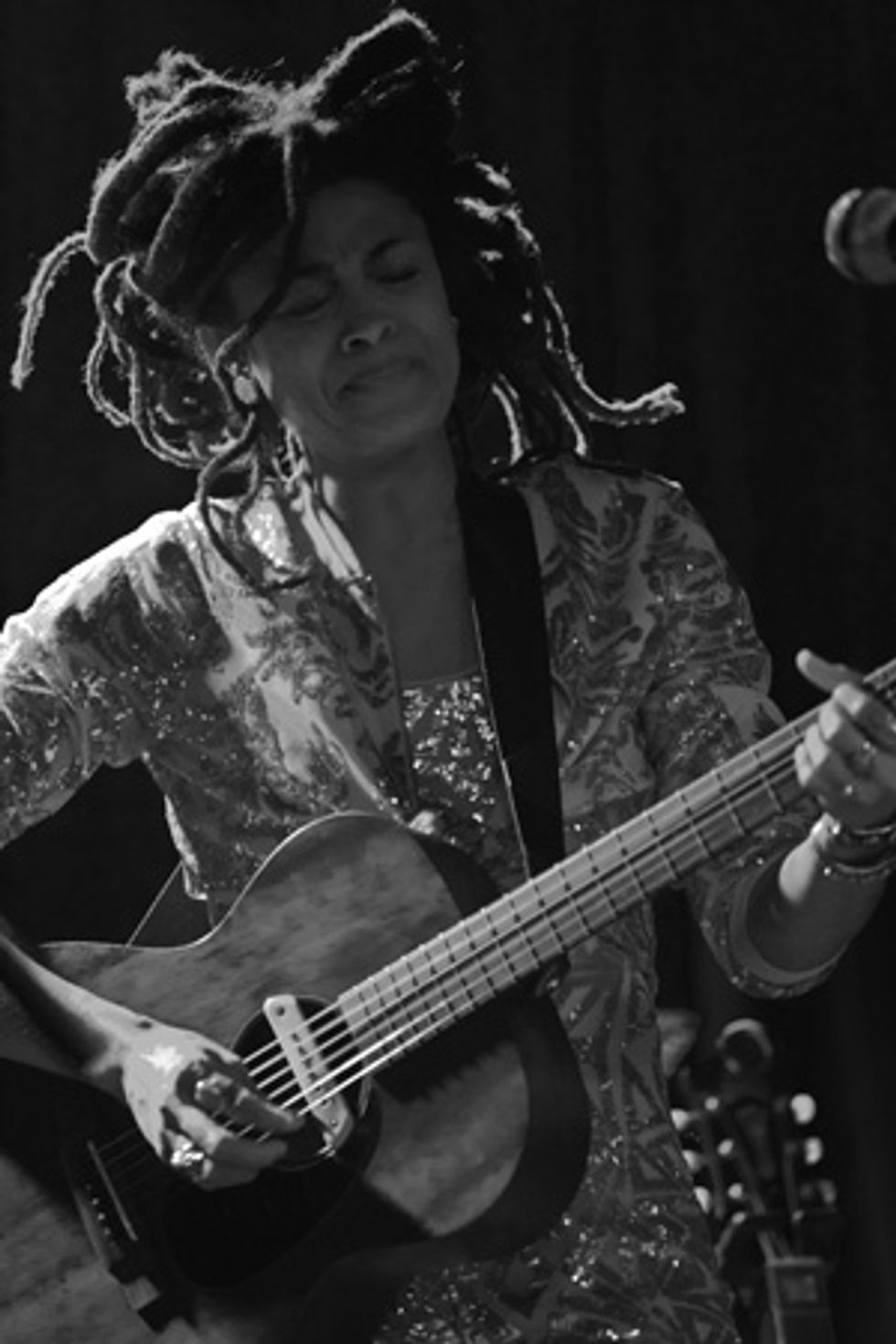
June was emotional while paying tribute to her late father during a sold-out homestate performance of her new single, “Astral Plane," at Nashville's 3rd and Lindsley club on February 16, 2017. Photo by Chris Kies
Besides your Guild and Martin 000-15, what other instruments are you traveling with?
I take my 5-string Gold Tone banjo on the road, and a 4-string baby ukulele banjo. At home I play an awesome 1930s Gibson banjo, and then Ry Cooder gave me one and it's a Vega, and it's really great and from the 1930s as well. But I don't like to take those on the road because they're just amazing. They're really old and delicate.
Do you still name your instruments?
I do, but I haven't figured out a name for the Guild and the Gibson [banjo] yet. I got the Gibson for my birthday last year, and I got the Guild a little bit before that so I think it takes a while sometimes to get a name out of 'em.
If your music had an odor, what would yours smell like?
Black pepper [laughs]. It's a little bit sweet and spicy. Every song's different though, so it's hard to think about it all as one thing. It would be more like a casserole, than like an individual ingredient. Or soup! The full recipe of something.
What do you think makes a great song?
I think the story. It's gotta be an amazing story. If it's not, then it's hard for me to say it's a great song. Some songs have nice hooks, and that's cool, I enjoy that, but I can't say I would call it a great song.
What was on your mind while making your new album?
I wrote the songs over the course of 10-12 years, so a lot of things would've been on my mind. But in making the album, and the actual time I spent in the studio recording the songs, I think that's where my brain started to go more technical. Is this sounding like what it sounded like in my head when I wrote it 10 years ago?
But the part I love the most is the songwriting and the story, and discovering what is happening with the song.
What's your favorite part about what you do? Why do you keep making music?
I keep getting songs, so that's why I keep doing it. I keep hearing songs, and keep writing 'em. So whenever I don't hear 'em anymore … I probably won't do it.
YouTube It
Valerie June goes back to basics with just her Martin 000-15, her fingers, and her voice in this live performance of “Just in Time" from her new album, The Order of Time.
Matt Marinelli produced Valerie June's sophomore studio album, and played guitar and bass on the recording. While playing in her touring band, his live workhorse is a 1968 Ampeg AMB-1 Scroll bass. Photo by Chris Kies
Studio Libero: Matthew Marinelli
It's easy to understand why Valerie June calls her producer Matthew Marinelli a “godsend."
It's one thing for a producer to interject, guide, and direct an artist, but it's another thing entirely when that same person instrumentally accompanies an artist on the record and the live performances.
Though he now favors bass, Marinelli's been playing guitar since age 12, and played either bass or guitar on virtually every track of Valerie June's The Order of Time. He's also her current touring bassist, and most of the guitars and amps used on the album are from his arsenal of vintage gear. This collaboration evolved naturally when Marinelli was doing front-of-house mixing for June. They started playing music together and dueting around town for fun, which proved to be a catalyst for June's album.
Matt Marinelli's Gear
Basses and Guitars1968 Ampeg AMB-1 Scroll bass (live)
1955 Martin 0-15 (“Long Lonely Road")
1962 Gibson ES-330 TDC (“Two Hearts" and “Slip Slide")
1979 Fender Telecaster (“Got Soul")
1960s Ampeg AEB-1 Scroll bass (“Long Lonely Road," “Love You Once Made," “Man Done Wrong," “If And")
1969 Fender Mustang bass (“Two Hearts" and “Astral Plane")
1960s Hofner President (“Slip Slide")
1953 Fender Precision (“Got Soul")
Versoul 8-string Swan bass (“Man Done Wrong")
Amps
Gallien Krueger GK800RB (live)
Aguilar DB410 (live)
Strings
La Bella bass strings
Ernie Ball Skinny Top Heavy Bottom Slinky (.010–.052)
“We ended up playing a couple of shows at a friend's bar in Brooklyn called Bar LunÀtico,"
says Marinelli. “We had to rush to put that set together, and we decided to do a bunch of her new tunes. So we had to figure out how to play some of these songs. As a duo, you hear things in your head and it came together in our minds. Not all the tunes on the record were done that way, but we had a good idea."
Two of the album's standout guitar solos, on “Long Lonely Road" and “Two Hearts," were written by Marinelli while accompanying June live before going into the studio. “For me, if there was going to be a guitar solo on the record, it was about having a different melodic section, more like a melodic development of the tune—a very simple, minimal solo approach," he says. “I always love country guitar solos where it
basically states the melody with little embellishment."
The Order of Time was tracked in just under a week at Guilford Sound in southern Vermont with Andy MacLeod on guitar, Dan Iead on pedal steel, Pete Remm on keys, and Dan Reiser on drums. “By the end of it, I don't think anyone wanted to leave," Marinelli says. “We wanted it to just be our new life where we just make music all day long."
Having a tight band and already knowing the foundations of June's songs so well gave the pair confidence to experiment with arrangements and sounds in the studio. For example, “Man Done Wrong" features two banjos, played by June, and two bass parts, played by Marinelli. Half of the parts are amped and half are acoustic, with all four parts stacked into a suantering, distinguished blues-folk lead.
“That line is great," says Marinelli. “I think Val's approach to banjo is different than a lot of people who come out of a more traditional bluegrass or country background. She's not afraid to play through an amplifier or try different things with it. So, on that tune in particular, there wasn't this overwhelming desire to make it a pristine, accurate acoustic recording of a banjo. We were trying to create something where everything melded together and became some other instrument in the process."


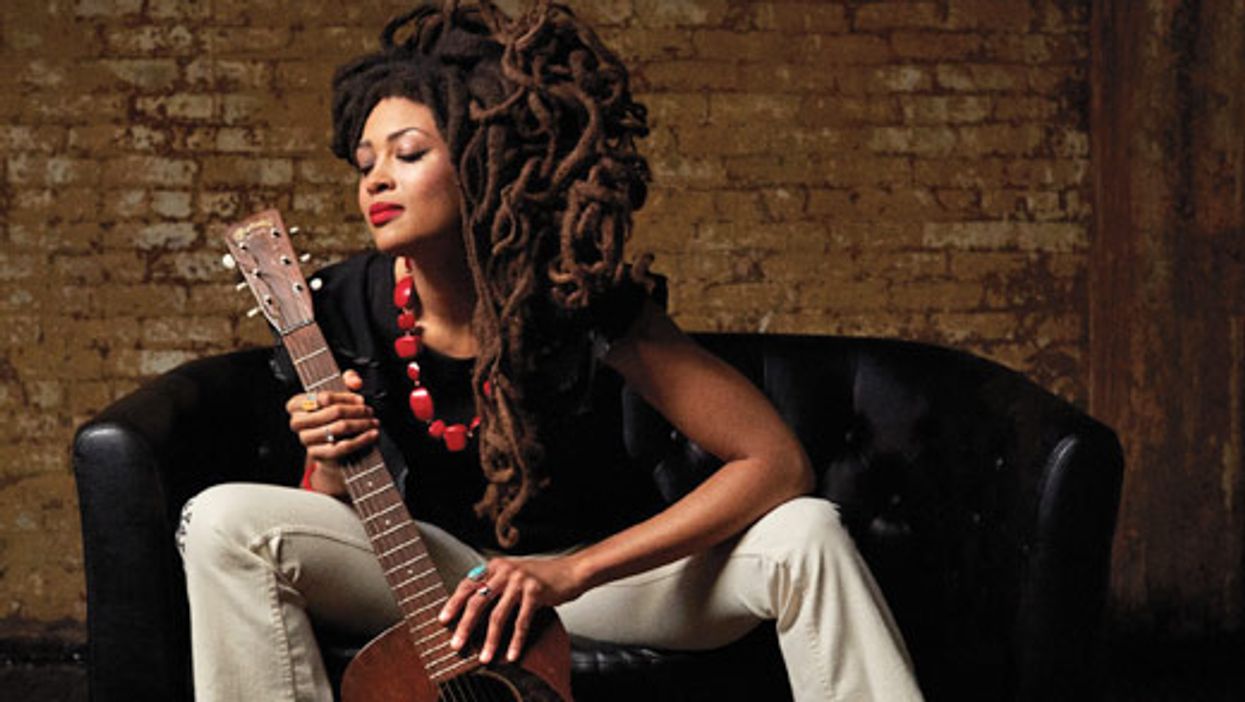

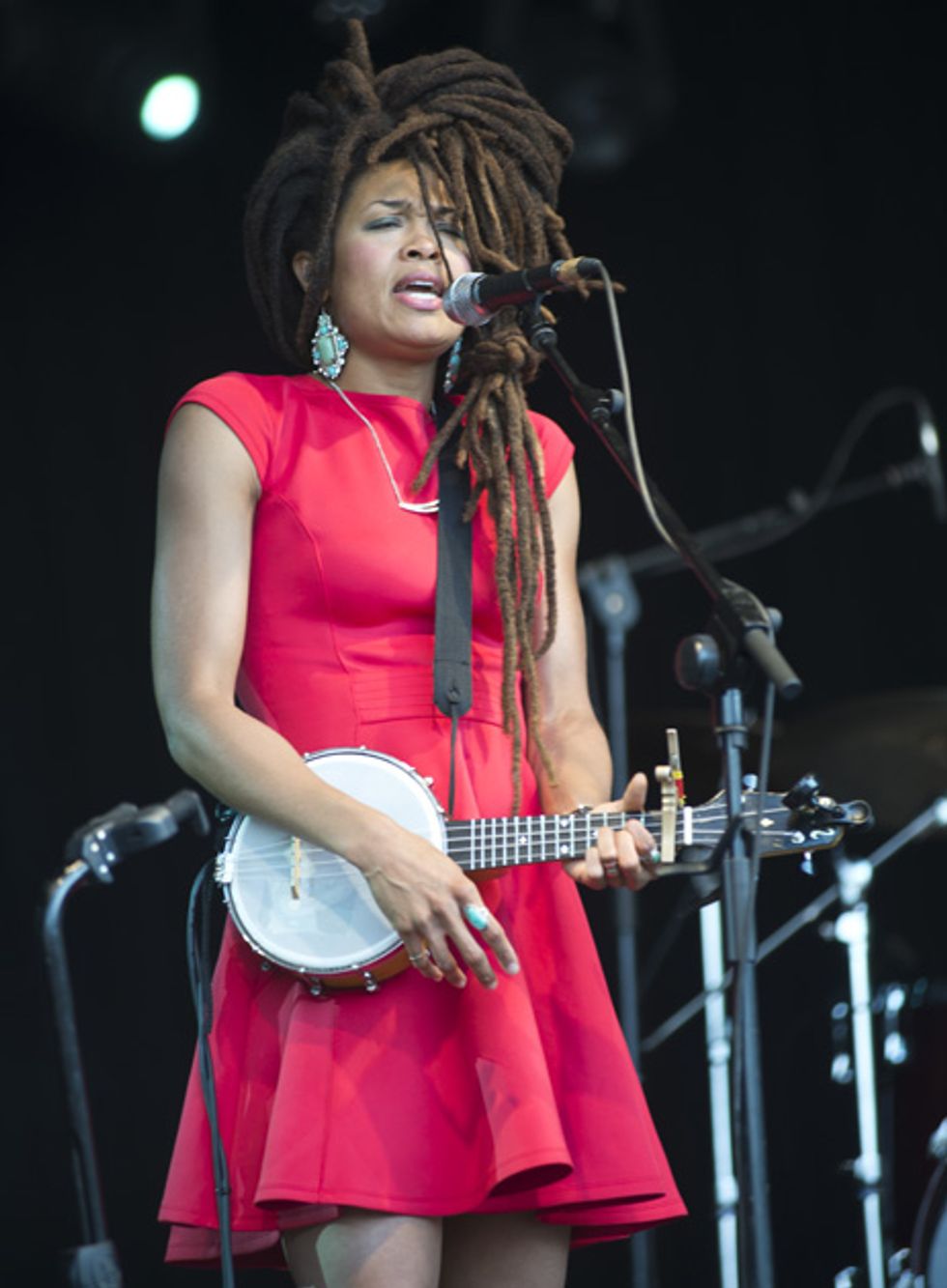
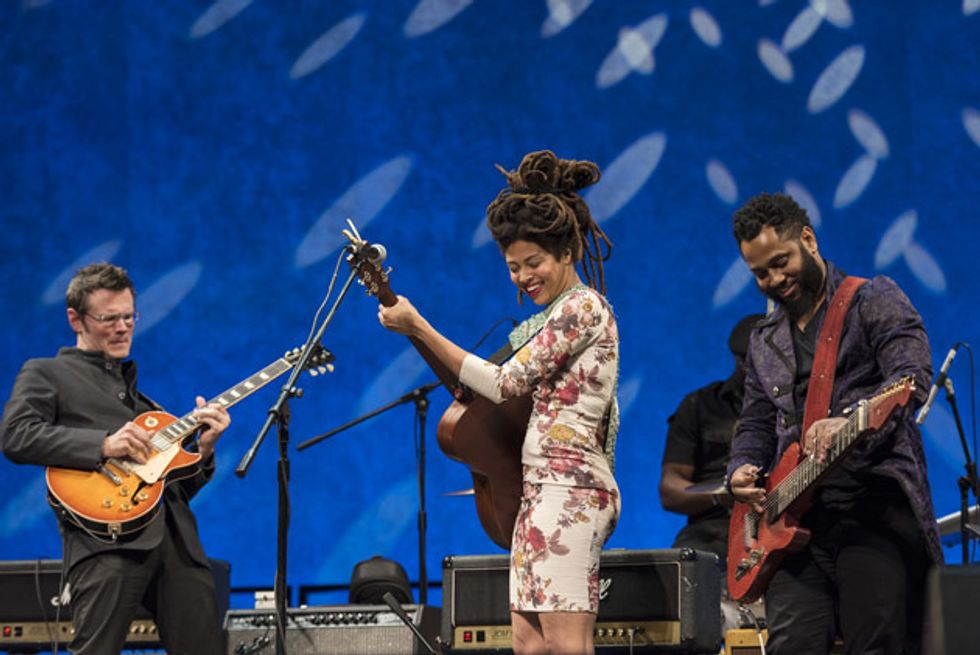
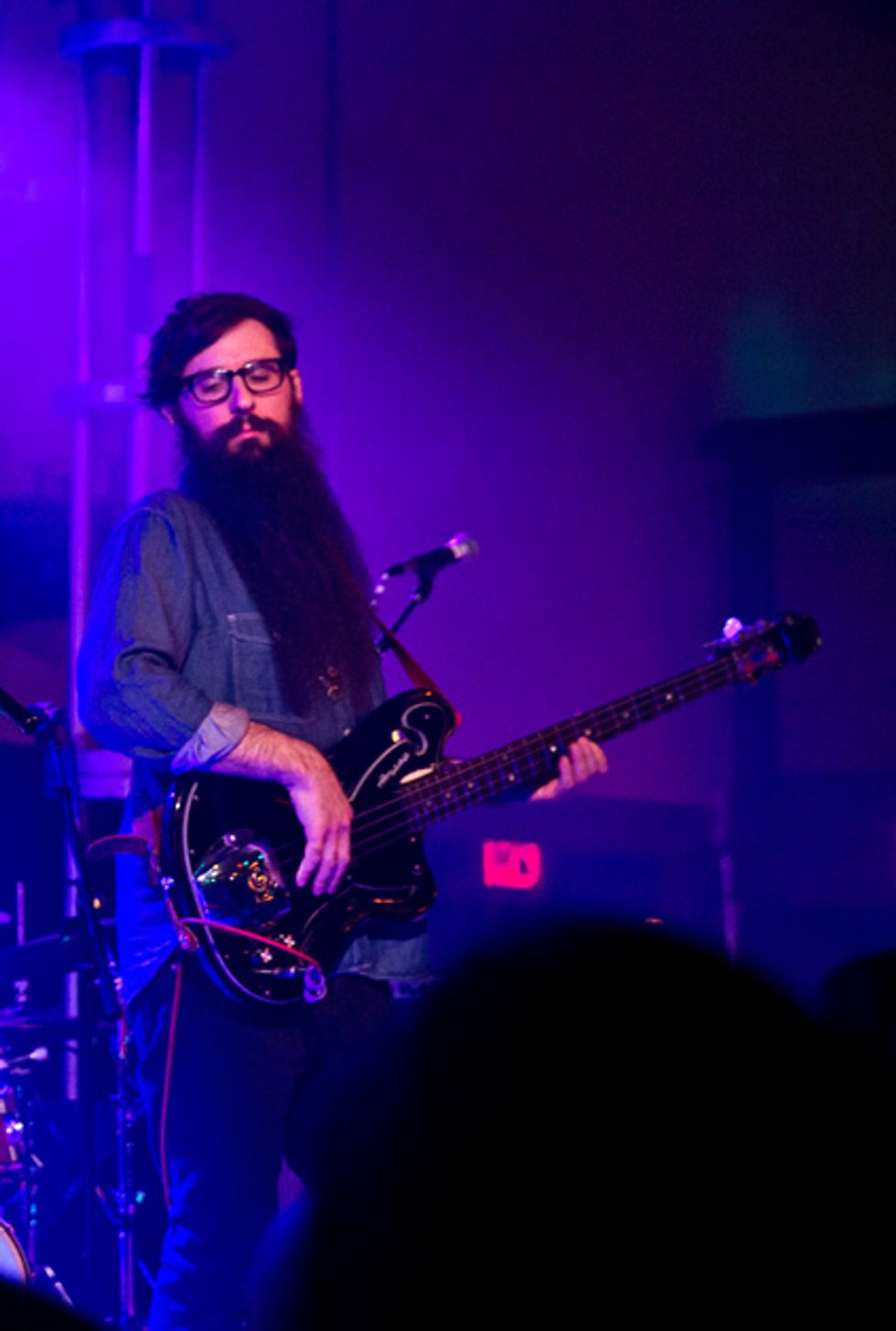








![Rig Rundown: Russian Circles’ Mike Sullivan [2025]](https://www.premierguitar.com/media-library/youtube.jpg?id=62303631&width=1245&height=700&quality=70&coordinates=0%2C0%2C0%2C0)












![Rig Rundown: AFI [2025]](https://www.premierguitar.com/media-library/youtube.jpg?id=62064741&width=1245&height=700&quality=70&coordinates=0%2C0%2C0%2C0)




















 Zach loves his Sovtek Mig 60 head, which he plays through a cab he built himself at a pipe-organ shop in Denver. Every glue joint is lined with thin leather for maximum air tightness, and it’s stocked with Celestion G12M Greenback speakers.
Zach loves his Sovtek Mig 60 head, which he plays through a cab he built himself at a pipe-organ shop in Denver. Every glue joint is lined with thin leather for maximum air tightness, and it’s stocked with Celestion G12M Greenback speakers.











